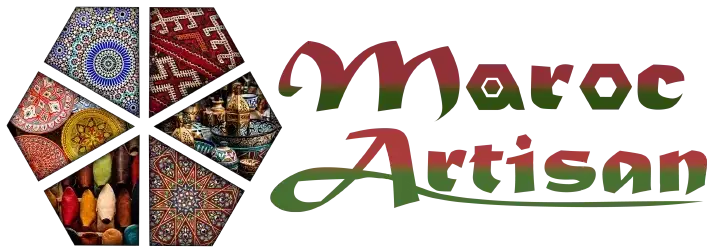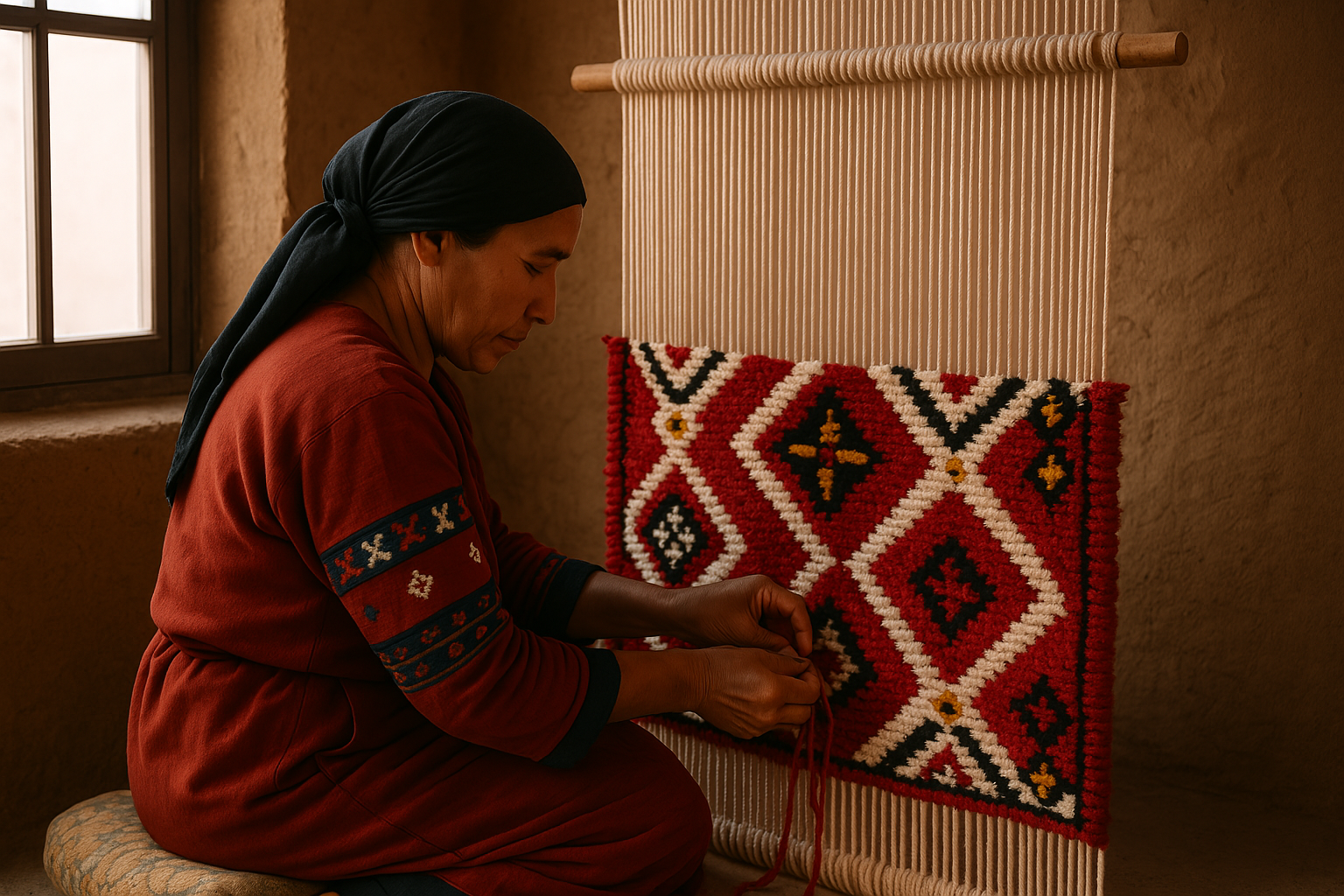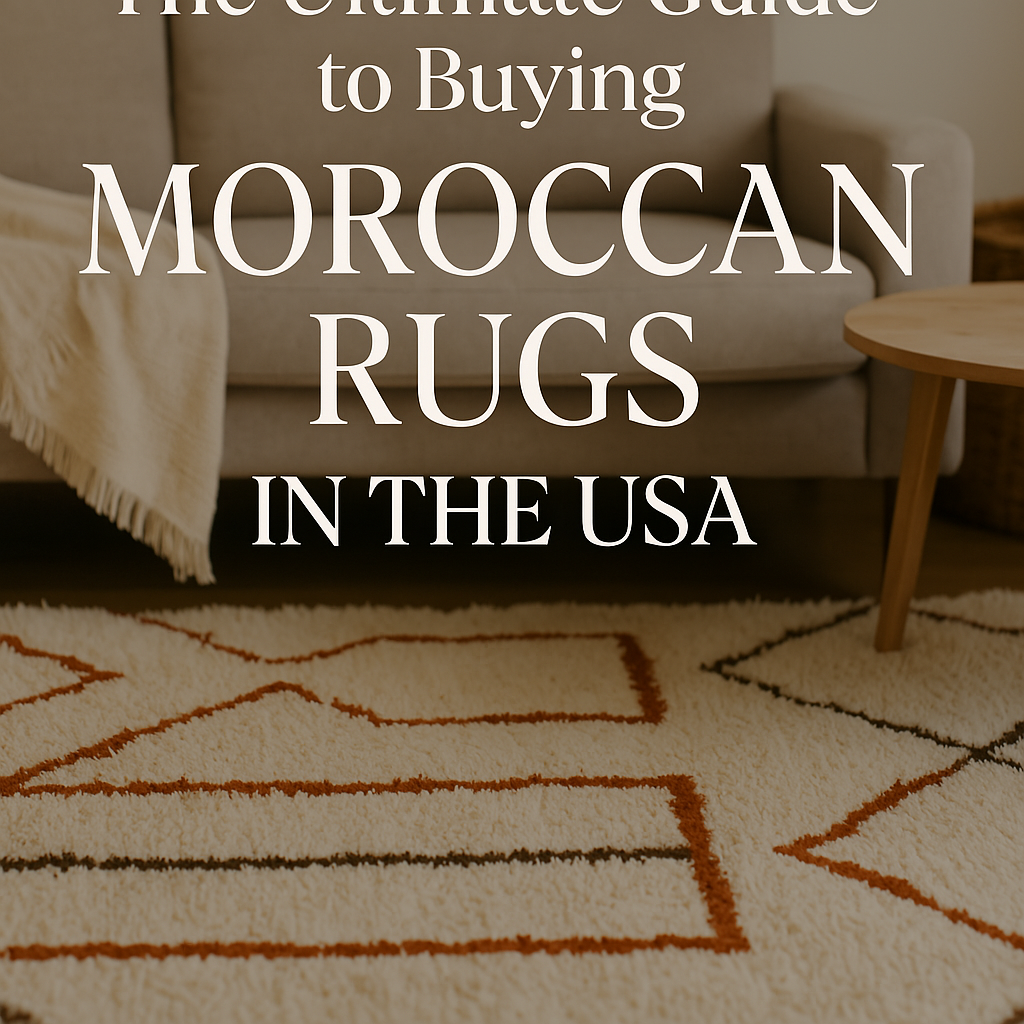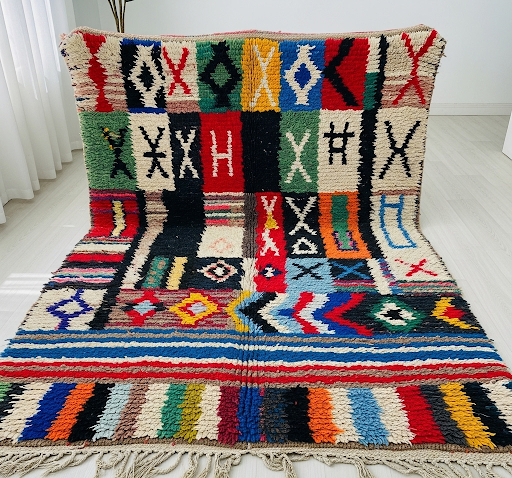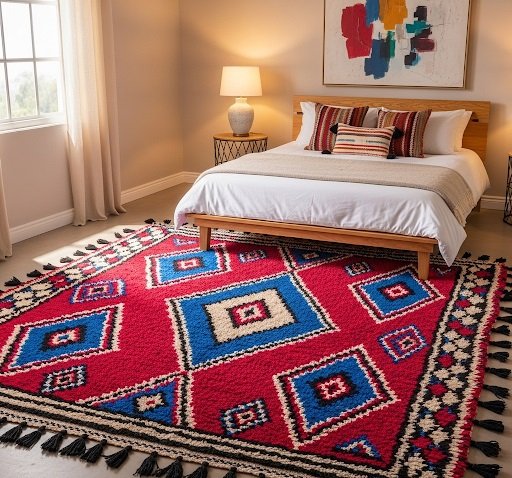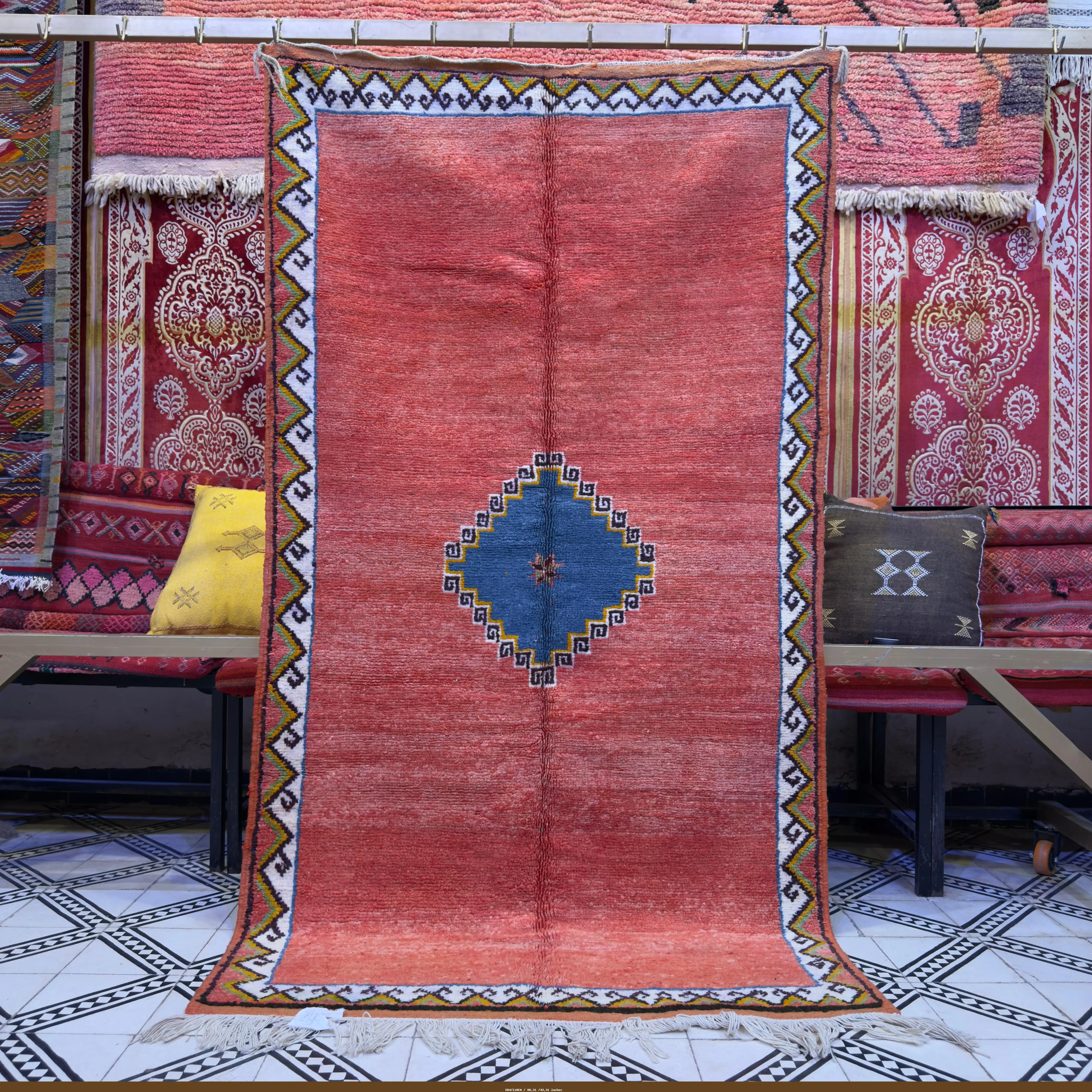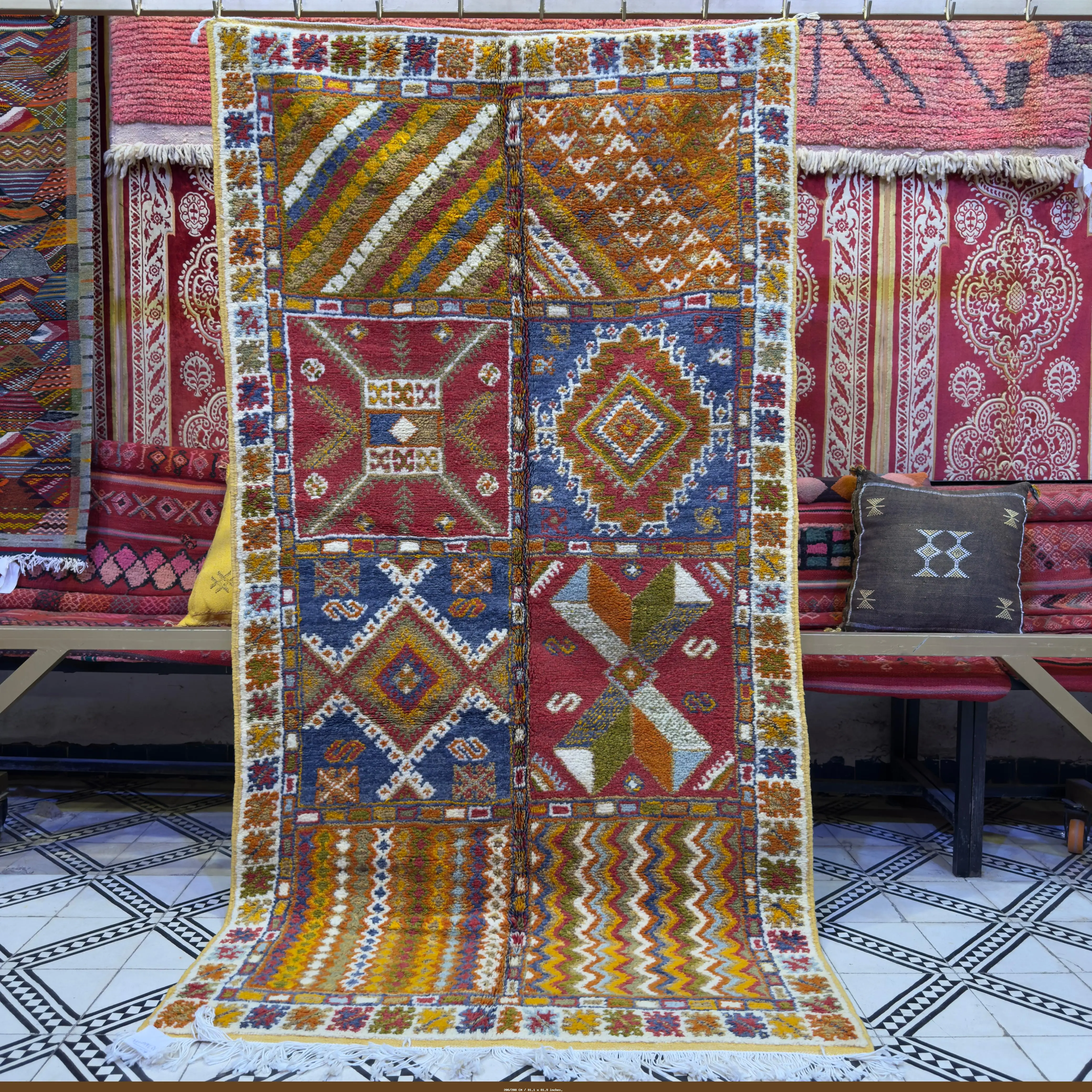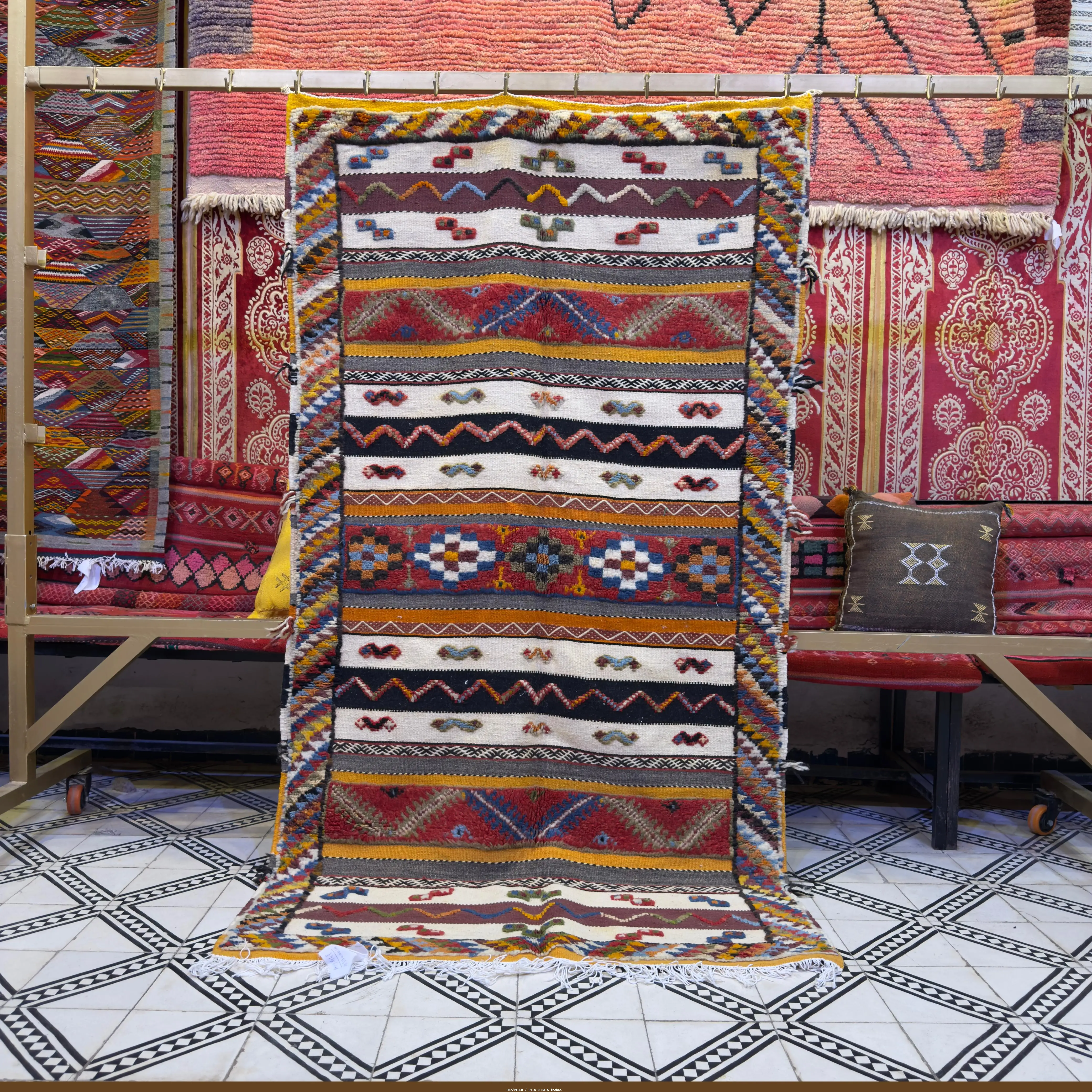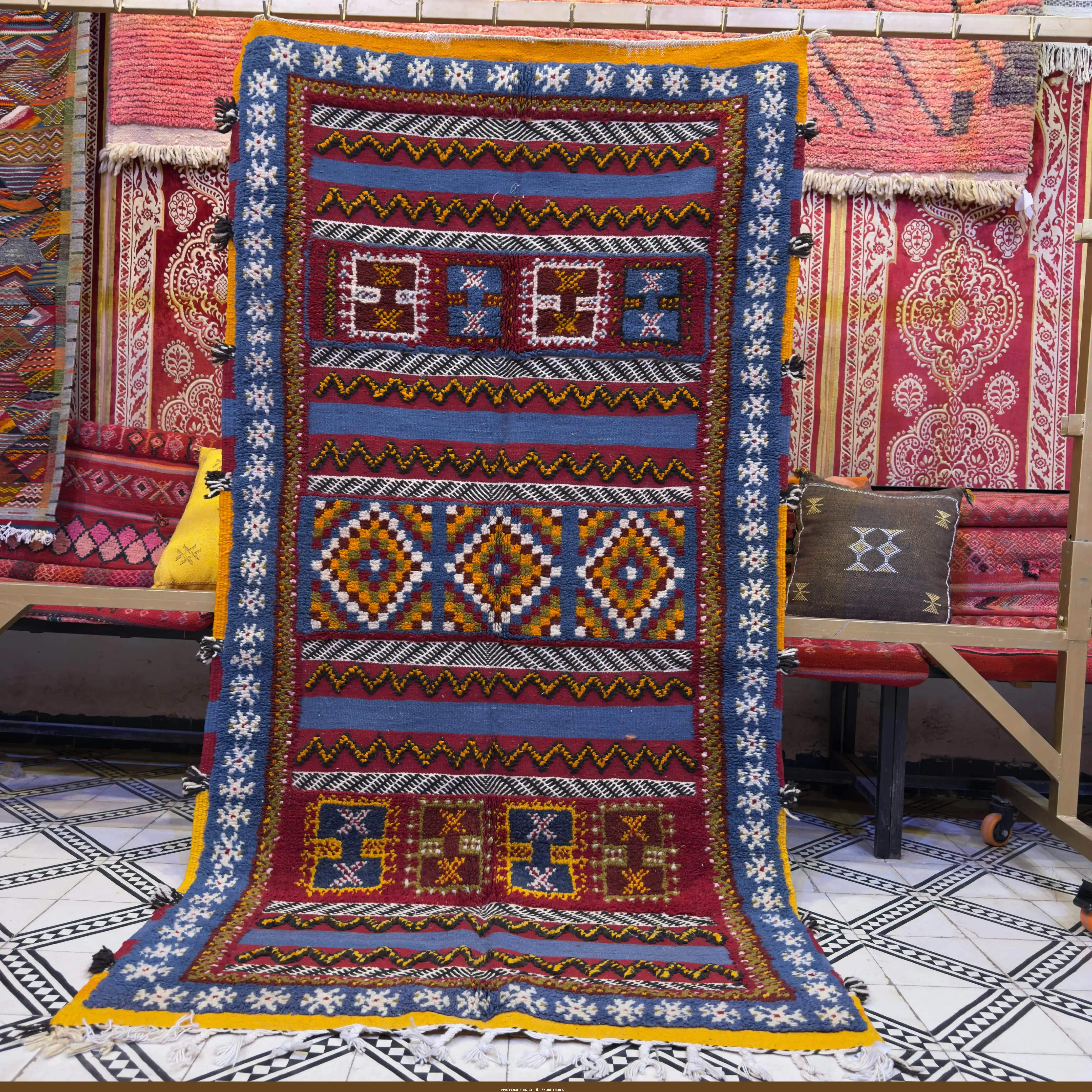The Ultimate Guide to Moroccan Rugs: Styles, History, and How to Choose the Perfect One
Step into the vibrant world of Moroccan rugs, where each thread tells a story of ancestral wisdom and artistic expression. These handcrafted treasures have transcended their humble origins in the Atlas Mountains to become coveted pieces in homes worldwide. More than mere floor coverings, authentic Moroccan rugs embody centuries of cultural heritage, with patterns and techniques passed down through generations of skilled artisans.
Whether you're drawn to the minimalist elegance of Beni Ourain designs, the colorful exuberance of Azilal weaves, or the resourceful charm of Boucherouite rag rugs, this guide will navigate you through the rich tapestry of Moroccan rug traditions. We'll explore their distinctive styles, uncover their fascinating history, and provide practical advice on selecting the perfect piece to transform your space with soulful, ethical design.
The Rich Heritage of Moroccan Rugs

The story of Moroccan rugs begins with the Berber tribes of North Africa, whose weaving traditions date back thousands of years. Unlike the formal designs of Persian carpets, Berber rugs emerged from necessity – created to provide warmth and comfort in the harsh mountain climate. Each tribe developed distinctive patterns and techniques, resulting in the diverse styles we cherish today.
These rugs weren't originally intended as decorative pieces but as essential household items – serving as bedding, seating, and protection from cold winter nights. The intimate connection between weaver and creation is what gives Moroccan rugs their soul and authenticity. Each piece carries the personal expression of its maker, often incorporating symbols that tell stories of tribal life, fertility, protection, and natural elements.
What makes these woven treasures particularly special is that they're primarily crafted by women. The art of rug-making is passed from mother to daughter, with techniques and design elements preserved through generations. This feminine heritage infuses the rugs with unique perspectives and narratives that reflect women's experiences within Berber culture.
"A Moroccan rug is not just a textile; it's a living artifact that carries the dreams, hopes, and artistic vision of its creator."
Today, as these rugs gain international recognition, there's a growing appreciation for their cultural significance and the importance of preserving authentic craftsmanship. The best Moroccan rugs still follow traditional methods, using natural materials and time-honored techniques that honor their rich heritage.
Key Styles of Moroccan Rugs
The diverse landscape of Morocco has given rise to a remarkable variety of rug styles, each with distinctive characteristics that reflect their region of origin. From the snowy Atlas Mountains to the sun-baked desert plains, these environments have shaped unique weaving traditions that continue to captivate the world.
Beni Ourain Rugs: Minimalist Elegance

Perhaps the most recognized of all Moroccan rug styles, Beni Ourain rugs originate from the snow-capped Middle Atlas Mountains. Crafted by the Beni Ourain tribe, these rugs feature natural undyed wool in ivory or cream with distinctive geometric patterns in black or brown. Their minimalist aesthetic has made them incredibly versatile in modern interiors.
What sets Beni Ourain rugs apart is their plush, deep pile – created to provide warmth during harsh mountain winters. The simple diamond patterns often represent fertility symbols and protective motifs, telling stories through their seemingly abstract designs. Their neutral palette allows them to complement virtually any decor style, from minimalist to bohemian.
Discover Authentic Beni Ourain Rugs
Explore our collection of handcrafted Beni Ourain rugs, each piece telling its own unique story through traditional patterns and techniques.
Explore Beni Ourain CollectionAzilal Rugs: Vibrant Expression

From the High Atlas Mountains come the exuberant Azilal rugs, known for their vibrant colors and expressive patterns. Unlike the restrained palette of Beni Ourain pieces, Azilal rugs celebrate color through the use of naturally dyed wool combined with cotton accents. Each rug tells a unique story through abstract symbols and geometric forms.
Azilal weavers often incorporate diamonds, triangles, and zigzag patterns that represent mountains, fertility, and protection. What makes these rugs particularly special is their improvisational nature – no two are exactly alike, as each weaver expresses her creativity freely. The result is a joyful, artistic piece that brings energy and character to any space.
Boucherouite Rugs: Creative Recycling

Born from necessity and ingenuity, Boucherouite rugs represent the resourceful spirit of Berber women. As wool became scarce or expensive, weavers began incorporating recycled textiles – from old clothing to fabric scraps – creating vibrant, eclectic pieces that celebrate color and texture. The name "Boucherouite" derives from a Moroccan-Arabic word meaning "a piece torn from used clothing."
These rugs break free from traditional patterns, embracing a playful, almost childlike quality in their designs. Their sustainable nature has made them increasingly popular in eco-conscious homes, while their exuberant colors and textures add personality to contemporary interiors. Each Boucherouite rug is truly one-of-a-kind, reflecting the creative vision of its maker.
Kilim Rugs: Geometric Precision

Moroccan Kilim rugs differ from their pile counterparts through their flat-woven technique. These lightweight, versatile rugs feature tight geometric patterns created through a meticulous weaving process. Their durability makes them ideal for high-traffic areas, while their precise patterns bring structured elegance to any room.
Traditional Kilims often incorporate symbolic motifs representing protection, fertility, and natural elements. Their flat surface showcases the intricate craftsmanship of the weaver, with each line and angle precisely executed. These rugs work beautifully in transitional spaces like hallways and entryways, adding cultural depth without overwhelming the space.
Mrirt Rugs: Plush Luxury

For those seeking the ultimate in tactile comfort, Mrirt rugs offer unparalleled luxury. Originating from the Middle Atlas region, these rugs feature an exceptionally thick, plush pile that creates a sumptuous feeling underfoot. Their deep, rich colors – often in warm reds, oranges, and browns – add a sense of opulence to any space.
Mrirt rugs typically showcase geometric patterns similar to Beni Ourain designs but with a denser, more luxurious texture. Their substantial weight and thickness make them perfect for bedrooms and living areas where comfort is paramount. These rugs not only provide visual warmth but also literal warmth – a true testament to their mountain origins.
Find Your Perfect Moroccan Rug
Browse our curated collection of authentic Moroccan rugs in various styles, sizes, and color palettes to find the perfect piece for your home.
Explore All Rug StylesThe Artistry of Moroccan Rug Craftsmanship

The creation of a Moroccan rug is a labor of love that can take weeks or even months to complete. This time-honored process begins with the gathering and preparation of materials, followed by meticulous weaving techniques that have been preserved for generations.
Materials: The Foundation of Quality
Authentic Moroccan rugs are crafted primarily from natural materials, with wool being the most common. This wool, harvested from sheep raised in the Atlas Mountains, possesses unique qualities that contribute to the rugs' distinctive character:
Beyond wool, many Moroccan rugs incorporate cotton for structural elements and accent details. Boucherouite rugs expand this material palette further, utilizing recycled textiles that add vibrant color and textural interest while demonstrating resourceful creativity.
Natural Dyes: Earth-Born Colors

Traditional Moroccan rugs derive their captivating colors from natural sources. These plant-based and mineral dyes create a harmonious palette that ages beautifully over time:
Indigo - Derived from the indigo plant, creating deep blues
Madder Root - Producing rich reds and oranges
Pomegranate - Yielding golden yellows and warm browns
Henna - Creating reddish-brown tones
Saffron - Providing vibrant yellows
Mint - Offering subtle green hues
The natural dyeing process requires extensive knowledge and patience. Dyes are prepared in large pots, with wool immersed for varying periods to achieve the desired color intensity. This traditional approach creates colors with depth and subtlety that synthetic dyes cannot replicate.
Weaving Techniques: Ancestral Knowledge
The weaving of Moroccan rugs employs several techniques, each requiring specific skills and producing distinctive results:
Most Moroccan rugs are created on vertical looms, with the weaver working from bottom to top. Patterns are rarely drawn out beforehand; instead, they exist in the weaver's mind, passed down through observation and practice. This improvisational approach contributes to the unique character of each piece.
A single high-quality Moroccan rug can contain over 500,000 individual knots, each tied by hand – a testament to the extraordinary patience and skill of Berber artisans.
Styling Your Space with Moroccan Rugs
The beauty of Moroccan rugs lies in their remarkable versatility. These artisanal pieces can enhance virtually any interior style, from minimalist modern to eclectic bohemian. Here's how to incorporate these cultural treasures into your home with confidence and flair.
Moroccan Rugs in Modern Interiors

The clean lines and neutral palette of Beni Ourain rugs make them perfect companions for modern interiors. Their geometric patterns add visual interest without overwhelming contemporary spaces, while their plush texture softens minimalist environments:
Moroccan Rugs in Bohemian Spaces

Vibrant Azilal and Boucherouite rugs shine in bohemian interiors, where their expressive patterns and rich colors contribute to a collected, well-traveled aesthetic:
Room-by-Room Styling Guide
Living Room
Anchor your seating area with a generously sized Beni Ourain or Azilal rug. Ensure the rug is large enough that at least the front legs of all furniture rest on it, creating a cohesive conversation area. The living room is where a statement Moroccan rug can truly shine as a focal point.
Bedroom
Place a plush Mrirt or Beni Ourain rug beside the bed to create a soft landing for bare feet. Alternatively, position a larger rug under the bed, extending at least 24 inches on all sides for a luxurious feel. The bedroom is perfect for showcasing the tactile comfort these rugs provide.
Dining Room
Choose a durable flat-weave Kilim for dining areas, ensuring the rug extends at least 24 inches beyond the table on all sides to accommodate chairs. The geometric precision of Kilim rugs brings structured elegance to dining spaces while withstanding the challenges of this high-traffic area.
Entryway
Welcome guests with a runner-style Kilim or small Azilal rug that sets the tone for your home's aesthetic. Entryway rugs should be durable enough to withstand traffic while making a strong design statement. A vintage piece here creates an immediate impression of thoughtful curation.
Home Office
Inspire creativity with a colorful Boucherouite or Azilal rug that energizes your workspace. Ensure proper sizing under rolling chairs by using a chair mat to protect the rug's surface. The vibrant patterns can stimulate thinking while the cultural connection reminds us of global craftsmanship.
Hallway
Guide movement through your home with a Moroccan runner that adds visual interest to transitional spaces. Hallway runners should be centered with equal floor space visible on either side. These often-overlooked areas are perfect for showcasing the linear designs of Kilim runners.
Transform Your Space with Authentic Moroccan Artistry
Browse our curated collection of handcrafted Moroccan rugs to find the perfect piece for your home.
Shop Moroccan RugsBuyer's Guide: How to Choose an Authentic Moroccan Rug
Navigating the world of Moroccan rugs can be both exciting and challenging. With their growing popularity has come an influx of mass-produced imitations that lack the soul and quality of authentic pieces. This guide will help you identify genuine Moroccan rugs and make an informed purchase that you'll treasure for years to come.
Authenticity Markers: What to Look For

Authentic Moroccan rugs bear distinctive characteristics that reveal their handcrafted nature:
Turn the rug over and examine the back. In authentic pieces, you should be able to see individual knots and the pattern should be clearly visible from the reverse side.
Ethical Sourcing: Supporting Artisans
When purchasing a Moroccan rug, consider not just the piece itself but the people behind it. Ethical sourcing ensures that artisans receive fair compensation for their extraordinary skill:
Ethically sourced rugs may command higher prices, but this investment supports sustainable craftsmanship and helps preserve cultural traditions that might otherwise be lost to mass production.
Price Considerations: Understanding Value
Authentic Moroccan rugs represent a significant investment, with prices reflecting their handcrafted nature and cultural significance. Understanding price factors helps set realistic expectations:
| Rug Type | Average Size | Price Range (USD) | Key Value Factors |
| Beni Ourain | 6' x 9' | $900 - $4,000 | Wool quality, knot density, age |
| Azilal | 5' x 8' | $800 - $3,000 | Color complexity, design uniqueness |
| Boucherouite | 4' x 7' | $400 - $1,500 | Composition, color vibrancy, complexity |
| Kilim | 5' x 8' | $600 - $10,000 | Weaving tightness, design intricacy |
| Mrirt | 6' x 9' | $1,000 - $4,500 | Pile height, wool quality, weight |
Factors that influence price include size, age, complexity, materials, and condition. Vintage pieces often command premium prices due to their historical significance and unique patina developed over time.
Sizing Guide: Finding the Perfect Fit

Selecting the right size is crucial for a Moroccan rug to enhance your space properly:
Remember that traditional Moroccan rugs often come in unusual sizes due to their handmade nature. Be flexible with your measurements and consider custom options for specific needs.
Caring for Your Moroccan Rug
A well-maintained Moroccan rug can last for generations, becoming more beautiful with age. These handcrafted treasures require specific care to preserve their beauty and integrity over time.
Regular Maintenance
Never use a vacuum with a rotating beater bar on pile rugs like Beni Ourain or Mrirt styles, as this can damage the delicate fibers and loosen knots.
Addressing Spills and Stains
Quick action is essential when accidents happen:
For stubborn stains or valuable rugs, consult a professional cleaner who specializes in handmade rugs.
Deep Cleaning
Every few years, your Moroccan rug will benefit from deeper cleaning:
The natural lanolin in wool provides some protection against staining, but prompt attention to spills will help maintain your rug's beauty for years to come.
Frequently Asked Questions About Moroccan Rugs
Are Moroccan rugs durable?
Yes, authentic Moroccan rugs are exceptionally durable when properly cared for. The high-quality wool used in traditional pieces contains natural lanolin that helps resist staining and wear. Many vintage Moroccan rugs have survived decades of use while developing a beautiful patina. The hand-knotted construction creates a sturdy foundation that can withstand regular foot traffic. However, different styles vary in durability – pile rugs like Beni Ourain and Mrirt are best for lower-traffic areas, while flat-weave Kilims can handle busier spaces.
How can I tell if a Moroccan rug is authentic?
Authentic Moroccan rugs display several key characteristics: slight irregularities in pattern (perfect symmetry often indicates machine production), natural materials with distinctive texture and scent, visible individual knots on the reverse side, and subtle color variations within dyed areas. Reputable sellers will provide information about the rug's origin, tribe, and approximate age. Price can also be an indicator – if a "handmade" Moroccan rug seems too inexpensive, it's likely mass-produced. When possible, examine the rug in person to feel the quality of materials and construction.
Do Moroccan rugs shed?
Some shedding is normal with new wool Moroccan rugs, particularly plush pile varieties like Beni Ourain and Mrirt. This shedding typically diminishes significantly after the first few months of use and regular gentle vacuuming. The amount of shedding varies by rug type – flat-weave Kilims shed minimally, while higher pile rugs may shed more initially. Excessive or prolonged shedding might indicate lower quality materials or construction. Regular maintenance helps manage shedding and extends the life of your rug.
What sizes do Moroccan rugs come in?
Traditional Moroccan rugs often come in non-standard sizes due to their handmade nature. Common dimensions range from small 3'x5' accent pieces to larger 8'x10' room-sized rugs. Runner styles for hallways typically measure 2-3' wide by 6-12' long. Vintage rugs particularly may have unusual dimensions based on the original weaver's specifications. Many sellers now offer custom sizing options, allowing you to commission a rug made to your exact requirements. When shopping, it's helpful to be flexible with size requirements or consider custom options for specific needs.
Are Moroccan rugs suitable for homes with children and pets?
Moroccan rugs can work well in homes with children and pets, though some styles are more suitable than others. The natural wool in authentic pieces is inherently stain-resistant and durable. For active households, consider Boucherouite rugs (their multicolored patterns help hide stains) or flat-weave Kilims (easier to clean and more durable underfoot). Higher-pile rugs like Beni Ourain might be better suited for lower-traffic areas. The good news is that wool naturally repels dirt and contains lanolin that helps protect against stains when addressed promptly.
How much should I expect to pay for a quality Moroccan rug?
Authentic handmade Moroccan rugs represent a significant investment, with prices reflecting their artisanal creation and cultural value. For a medium-sized (5'x8') authentic piece, expect to pay between $800-$3,000 depending on the style, age, and complexity. Beni Ourain and Mrirt rugs typically command higher prices due to their labor-intensive pile construction, while Boucherouite rugs are often more affordable. Vintage pieces generally cost more than contemporary ones. While mass-produced imitations are available at lower price points, they lack the quality, character, and ethical production of authentic pieces.
Embracing the Soul of Morocco in Your Home
Moroccan rugs represent far more than beautiful floor coverings – they embody centuries of cultural heritage, artistic expression, and human connection. Each handcrafted piece carries within its fibers the stories of the artisans who created it, the landscapes that inspired it, and the traditions that shaped it.
By welcoming an authentic Moroccan rug into your home, you're not only enhancing your space with exceptional beauty and craftsmanship but also participating in the preservation of vital cultural traditions. These living artifacts connect us to a rich heritage of textile art while supporting the communities who continue these time-honored practices.
Whether you're drawn to the minimalist elegance of a Beni Ourain, the vibrant expression of an Azilal, or the resourceful creativity of a Boucherouite, there's a Moroccan rug waiting to transform your space with its unique character and soul.
Discover Your Perfect Moroccan Treasure
Explore our curated collection of authentic, ethically-sourced Moroccan rugs and bring home a piece of this extraordinary cultural heritage.
Browse Our Collection